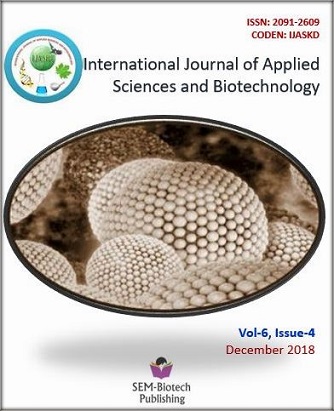Green Synthesis of Silver Nanoparticles Using Different Plant Materials and Their Antibacterial Activity
DOI:
https://doi.org/10.3126/ijasbt.v6i4.22112Abstract
The green route of metal nanoparticles synthesis has received significant attention in recent years due to it's cost-effective, non-toxic and eco-friendly nature in comparison to other physical and chemical methods. This study reports on the synthesis of silver nanoparticles (Ag-NPs) from bio-reduction of 1mM aqueous silver nitrate (AgNO3) by extracts prepared from three different plants namely, Brassica oleracea L. var. italica Plenck (Broccoli), Capsicum annuum L. (Chili) and Parthenium hysterophorus L. (Carrot grass). The synthesized Ag-NPs were characterized using UV- visible spectroscopy, Fourier Transform Infrared Spectroscopy (FTIR) and Scanning Electron Microscopy (SEM). Ag-NPs synthesized showed the surface plasmon resonance with the appearance of absorption peaks around the range of 410-430 nm. The possible biomolecules involved in the reduction and the stabilization of synthesized Ag-NPs were found to be alcoholic, phenolic, amine and carbonyl groups. SEM study revealed that Ag-NPs were spherical in shape with varied size about 10-40 nm. Besides, the analysis of antioxidant and antibacterial activities of Ag-NPs was carried out. The Ag-NPs synthesized using B. oleracea extract showed the higher antioxidant activity than Ag-NPs synthesized from both C. annuum & P. hysterophorus extracts. Ag-NPs exhibited good antibacterial activity against both Gram-negative (Escherichia coli) and Gram-positive (Staphylococcus aureus) bacteria. The higher antibacterial activity was shown by Ag-NPs synthesized from P. hysterophorus extract in comparison to Ag-NPs synthesized from both C. annuum & B. oleracea extracts. Hence, it can be concluded that Ag-NPs synthesized following the green route could be the source for potential antioxidant and antibacterial agents.
Int. J. Appl. Sci. Biotechnol. Vol 6(4): 294-301




